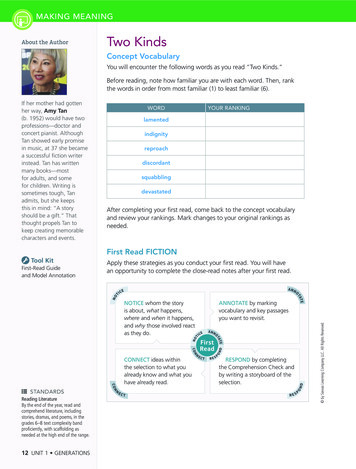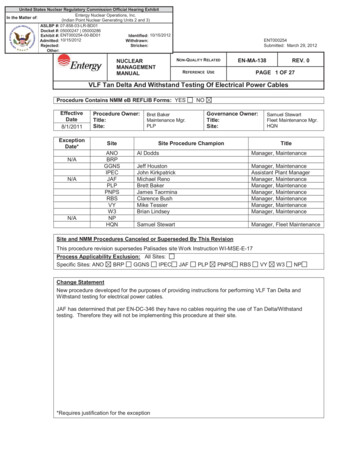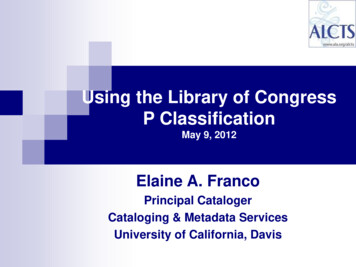
Transcription
Schema Therapy for Borderline Personality Disorder: Patients’ andTherapists’ PerceptionsByTan Yeow May, B.A. (Hons)This thesis is presented for the degree ofDoctor of Clinical Psychologyat Murdoch University2015
I declare that this thesis is my own account of my research and contains as itsmain content work which has not previously been submitted for a degree at anytertiary education institution. .Tan Yeow May
Schema Therapy for Borderline Personality Disorder: Patients’ andTherapists’ PerceptionsTan Yeow MayMurdoch UniversityPERTH, WESTERN AUSTRALIAABSTRACTSchema therapy (ST) is effective in promoting clinically meaningful gains thatameliorate symptomatology for borderline personality disorder (BPD). Howeververy little is known about how the therapy is experienced by patients ortherapists including which elements of ST are effective from patients’ andtherapists’ perspectives. The aim of this study is to explore BPD patients’experiences of receiving ST and therapists’ experiences in delivering ST.Qualitative data were collected through semi-structured interviews with 11patients who had a primary diagnosis of BPD and eight trained schematherapists. Interview data were analysed following the procedures of inductive,content analysis. Patients’ broad perceptions of ST included the experience ofgreater self-understanding, better awareness of their own emotional processesand better connections with their emotions. While the process of ST wasperceived as emotionally confronting, patient narratives highlighted that thiswas perceived as necessary. Therapists generally regarded their experience asrewarding based on patients’ positive responses to treatment, and discussedchanges made in their professional (e.g. incorporating more ST in their therapy)and personal (e.g. increased self-awareness) lives. However therapists alsodescribed being confronted with novel challenging situations despite having
years of therapy experience. Patients and therapists were concordant on severaltherapeutic components of ST (e.g. ST provides insight, benefits of experientialtechniques) and some therapeutic group factors not specific to ST (e.g. sense ofconnection among group members). On the other hand there exists a possibleinterplay between level of patient dysfunction within the group and therapists’ability to manage group conflict. Recommendations for more effectiveimplementation of schema therapy are discussed as well as issues for otherspecialist treatment approaches to BPD particularly concerning termination oftherapy and definitions of recovery. Finally implications of the findings arediscussed in terms of assessing the suitability of patients for group ST.
ACKNOWLEDGEMENTSMy principal supervisor Dr. Christopher Lee was whom I received the mostadvice and direction for this thesis. I am very thankful for his guidancethroughout the entire process of refining the topic and scope of my research,recruitment of participants, analysis of data and the final write-up.I also wish to thank my secondary supervisor Prof. Arnoud Arntz who providedhis expertise on qualitative research and constructive feedback for the thesiswrite-up. The paper has been written by myself and edited by Dr. ChristopherLee and Prof. Arnoud Arntz. All errors and mistakes are however mine alone. Icould not have asked for more committed and knowledgeable supervisors, whowere not only generous with their time but also have a strong passion for theirfield of work.I would like to extend my appreciation to staff members at Rockingham andPeel mental health facilities who have assisted me in one way or another (e.g.booking of rooms, signing of progress notes), most importantly all the patientsand therapists who shared their very personal accounts, without whom thisthesis would not have been possible. Additionally I am grateful for the help oftwo Dutch postgraduate students Desiree Martius (PhD candidate) and SophieWastiaux (MSc candidate) for the countless Skype meetings to discuss theinterpretation and refining of interview data.Finally I sincerely thank my partner Nick, my family and friends who providedendless love, encouragement and laughter.
Table of Contents1. Introduction . 11.1 Borderline Personality Disorder (BPD). 11.1.1 Epidemiology of BPD . 21.1.2 Impact of BPD . 41.1.3 Aetiology of BPD . 71.2 Limitations of Existing Treatment Modalities . 81.2.1 Pharmacological treatment . 81.2.2 Ineffectiveness of traditional Cognitive-Behavioural Therapy . 91.2.3 Specialist Psychological Interventions for BPD. 101.3 Development of Schema Therapy for BPD . 151.3.1 Mechanisms of Schema Therapy for BPD . 171.3.2 Limitations of published articles on Individual and Group SchemaTherapy . 191.3.3 Group Schema Therapy . 211.3.4 Combined Group and Individual Schema Therapy . 231.4 Therapists’ and Patients’ Perceptions of Therapy . 241.4.1 Patients’ Perspectives of Recovery from BPD . 241.4.2 Patients’ Perspectives of Imagery . 251.4.3 Differing Perceptions of Therapy . 261.5 Rationale for Present Study . 281.5.1 Research Aims and Implications . 292. Method – Patient Participants. 312.1 Patient Profiles . 312.2 Procedure . 322.3 Data Analysis . 342.4 Inter-Coder Agreement . 342.5 Interview data specific to the Australian site . 373. Results – Patient Participants . 383.1 Part One: General experiences of Schema Therapy . 383.1.1 A. Therapeutic and challenging aspects of ST in general . 393.1.2 B. Perceptions of ST as compared to previous therapies . 463.1.3 C. Expectations, Feelings and Beliefs prior to and after starting ST
. 503.2 Part Two: Group and Individual components of Schema Therapy . 523.2.1 A. Group experience and dynamics among group members . 543.2.2 B. Structure and Format of Group and Individual ST . 623.2.3 C. Relationship with group and individual therapists . 694. Discussion – Patient Participants . 734.1 Therapeutic Gains attributed to Components of the Schema Model . 774.2 Group Factors that Contribute to Therapeutic Gains . 814.3 Factors that Disrupt Group Climate . 844.4 Termination of Schema Therapy . 854.5 Study Strengths. 864.6 Limitations. 874.7 Clinical Implications and Conclusion . 885. Method – Therapist Participants . 925.1 Schema Therapist Profiles . 925.2 Schema Therapy Supervision . 935.3 Procedure . 935.4 Data Analysis . 946. Results – Therapist Participants . 956.1 Part One: Group and individual therapists’ broad experiences in providingschema therapy . 956.1.1 A. Overall experiences of delivering ST . 976.1.2 B. General aspects and specific elements of the Schema model perceivedas therapeutic for patients . 1026.1.3 C. Therapists’ perceptions of ST as compared to previous therapyexperiences . 1066.1.4 D. Impressions of ST Training and Supervision . 1116.2 Part Two: Group therapists’ experiences within the group . 1146.2.1 A. Experiences as a group schema therapist/being part of the group . 1146.2.2 B. Factors to consider for productive schema group . 1177. Discussion – Therapist Participants . 1217.1 Components of the Schema Model perceived as Therapeutic for Patients 123
7.2 Impressions of ST Training and Supervision . 1297.3 Factors Necessary for Schema Group to be Productive . 1307.4 Study Strengths. 1337.5 Limitations. 1347.6 Clinical Implications and Conclusion . 1348. Overall Discussion and Conclusion. 1408.1 Implications and Recommendations for Future Research . 1448.2 Final Conclusion. 148References . 150
AppendicesAppendix A Aetiology of Borderline Personality Disorder . 177Appendix B Mode groups associated with Borderline Personality Disorder . 178Appendix C Inclusion and exclusive criteria . 179Appendix D Information letter for participants . 180Appendix E Consent form for patients . 181Appendix F Interview questions for patients . 182Appendix G Information letter for therapists . 183Appendix H Consent form for therapists . 184Appendix I Interview questions for therapists . 185
List of TablesTable 1 DSM-V diagnostic criteria for borderline personality disorder (301.83). 2Table 2 Patient participants characteristics . 32Table 3 Inter-Coder agreement . 37Table 4 Patients’ broad perceptions of Schema Therapy . 39Table 5 Group and individual components of Schema Therapy . 53Table 6 Schema therapist profiles. 93Table 7 Therapists’ broad experiences in providing Schema Therapy . 96Table 8 Experiences as a group schema therapist. 114
SCHEMA THERAPY FOR BORDERLINE PERSONALITY DISORDER1Chapter One: Introduction1.1 Borderline Personality Disorder (BPD)Borderline personality disorder (BPD) is a debilitating psychologicalcondition causing substantial distress and functional impairment across manyareas of life. Patients with BPD primarily suffer from problems including butnot limited to impulsive behaviours, patterns of unstable affect andinterpersonal relationships characterised by idealisation and devaluation,uncertain self-identities and acts of self-harm (American PsychologicalAssociation [APA], 2013). According to current psychiatric nosology, theDiagnostic and Statistical Manual of Mental Disorders – fifth edition (DSM-V)specifies that a diagnosis of 1BPD requires at least five of the nine criteriasummarised in Table 1. While there is no singular category “borderlinepersonality disorder” in the International Classification of Diseases, 10threvision (ICD-10; World Health Organisation, 1994), an equivalent categoryF60.31 – “Emotionally unstable personality disorder, borderline type” exists.The psychoanalytic perspective of “borderline personality organisation” ismore encompassing than these diagnostic classifications, and includes abroader range of psychological disorders.1Criteria for BPD remain unchanged from DSM-IV-TR
SCHEMA THERAPY FOR BORDERLINE PERSONALITY DISORDER2Table 1DSM-V diagnostic criteria for borderline personality disorder (301.83)1. Frantic efforts to avoid real or imagined abandonment2. A pattern of unstable and intense interpersonal relationships characterisedby alternating between extremes of idealisation and devaluation3. Identity disturbance: Notably and persistently unstable self-image or senseof self4. Impulsivity in at least two areas that are potentially self-damaging (e.g.,spending, sex, substance misuse, reckless driving, binge eating)5. Recurrent suicidal gestures, or threats or self-mutilating behavior6. Affective instability caused by a distinct reactivity of mood (eg, intenseepisodicdysphoria, irritability, or anxiety usually lasting a few hours and only rarelymore than a few days)7. Chronic feelings of emptiness8. Inappropriate intense anger or difficulty controlling anger (e.g., frequentdisplays of temper, constant anger, recurrent physical fights)9. Transient, stress-related paranoid ideation or severe dissociative symptoms1.1.1 Epidemiology of BPDIn a nationwide epidemiological survey based on 10,641 respondents,lifetime prevalence of BPD within Australia was estimated to be 0.8% (Jackson& Burgess, 2004). A review conducted based on 11 epidemiological studiesmajority of which from the United States reported significantly higher mean-
SCHEMA THERAPY FOR BORDERLINE PERSONALITY DISORDER3median lifetime prevalence for BPD of 1.4-1.6% (Torgersen, 2012). BPD wasalso found to be the most commonly represented personality disorder in clinicalpopulations, affecting an average of 28.5% of psychiatric patients comprisingmostly outpatients (Torgersen).Females are three times more likely to suffer from BPD in mentalhealthcare settings while no significant differences were found between malesand females within community settings (National Collaborating Centre forMental Health [NCCMH], 2009). This discrepancy may be attributed to thedifferent manifestations of BPD symptoms in both genders. Men with BPD aremore likely to suffer from substance abuse, aggressive and antisocial features,therefore presenting in correctional settings such as prisons. In contrast, womenwith BPD tend to have co-occurring diagnoses of PTSD or eating disorders andengage more in self-harming behaviours, therefore are more likely to present inmental health settings such as crisis services and the emergency department(Sansone & Sansone, 2011).The onset of BPD typically begins during young adulthood, withsymptoms becoming apparent in adolescence. While there may be somesimilarities between BPD markers and adolescent behaviour such as excessivesensitivity to rejection, interpersonal problems and self-harm, the presence ofsuch manifestations increases the risk of developing BPD nine-fold (Winograd,Cohen, & Chen, 2008). Recent literature has documented high rates ofremission (i.e. meeting less than three diagnostic criteria for BPD for more than12 months) of 85% over 10 years (Gunderson et al., 2011) and 78% to 99%over 16 years (Zanarini, Frankenburg, Reich, & Fitzmaurice, 2012). Howeverdespite sustained remission, Gunderson et al. reported that only 25% of patients
SCHEMA THERAPY FOR BORDERLINE PERSONALITY DISORDER4held full-time jobs while 40% remained reliant on disability pensions even after10 years. Recovery from BPD, as defined by symptomatic remission andclassification of “good social and vocational functioning” was found in only50% of patients after 16 years (Zanarini et al.). In addition, remission andrecovery are more difficult to achieve with BPD compared to other personalitydisorders (Zanarini et al.). More often than not, there are high comorbidity rateswith other psychiatric conditions, complicating the treatment course of BPD.BPD patients generally have high rates of comorbidity, especially moodand anxiety disorders, disorders related to substance use and other personalitydisorders; up to 85% and 74% of BPD patients receive concurrent axis-I andaxis-II diagnoses respectively (Grant et al., 2008; Lenzenweger et al., 2007). Inparticular, BPD is most frequently comorbid with major depression (Biskin &Paris, 2013; Zanarini et al., 1998). This combination of BPD with depressionincreases patients’ subjective levels of distress often leading to a higherfrequency and severity of suicidal behaviour (Soloff, Lynch, Kelly, Malone, &Mann, 2000). Among personality disorders, paranoid, passive-aggressive andavoidant personality disorders are most frequently comorbid with BPD(Barrachina et al., 2011). A positive relationship was found between thenumber of axis-II comorbidities and the clinical severity of BPD (Barrachina etal.).1.1.2 Impact of BPDWhile some individuals with BPD are able to lead fulfilling lives, manycontinue to suffer from a poor quality of life, requiring significant assistancefrom mental health services and support from friends and family. Skodol and
SCHEMA THERAPY FOR BORDERLINE PERSONALITY DISORDER5colleagues (2002) found that individuals with BPD have lower educationattainment, greater functional impairment in occupational status, socialrelationships, leisure and recreation as compared to individuals with depressionand obsessive-compulsive personality disorder. Not only does the continuouslack of productivity result in impairments to acquire and sustain employment,interpersonal difficulties often contribute to unstable and disrupted personalrelationships. A variety of self-destructive and impulsive behaviours such asreckless driving, unsafe sex and eating problems are also common in thispopulation. Additionally it was found that women with BPD reported higherself-stigma compared to women with social phobia (Rüsch et al., 2006), whereself-stigma is described as an individual’s internalised feelings of shame, guilt,diminished self-esteem and fear of discrimination associated with mental illness(Brohan, Slade, Clement, & Thornicroft, 2010).Recurrent suicidal behaviour is a defining feature of BPD (Gunderson& Ridolfi, 2001; Sansone, 2004; Soloff & Fabio, 2008) and for this reason,BPD is often regarded as the most lethal form of mental illness and the mostsevere personality disorder (Chanen, McCutcheon, Jovev, Jackson, &McGorry, 2007). Stanley and Brodsky (2005) differentiated between two formsof deliberate suicidal behaviours; the first form consists of self-destructive actswith some intent to die while the second form involves non-suicidal selfharming behaviours. It was estimated that more than 75% of individuals withBPD engage in a repeated pattern of non-lethal (e.g. superficial cutting,burning) self-harming behaviours (Stanley & Brodsky) for a range of reasonssuch as distraction, anger expression and reconnection with their feelings(Brown, Comtois, & Linehan, 2002). Despite the absence of suicidal intent, the
SCHEMA THERAPY FOR BORDERLINE PERSONALITY DISORDER6risk of eventual suicide remains with repeated self-injury. In fact, a diagnosis ofBPD was identified as the strongest predictor of suicide within a populationwith a history of inpatient psychiatric treatment (Tidemalm, Elofsson,Stefansson, Waern, & Runeson, 2005). Depending on the study methodology,completed suicides among individuals with BPD were estimated to be betweenapproximately 8.5% (Paris, 2002) and 10% (Oldham, 2006).In addition to emotional distress and functional impairment, theeconomic impact of BPD is significant; amounting to considerable financialcosts to society. Rendu, Moran, Patel, Knapp and Mann (2002) explored theeconomic impact of personality disorders in the UK; the average cost forprimary care attenders with a personality disorder diagnosis was estimated to beover 3,000 (A 5,500) and approximately 1,600 (A 3,000) to those without.These costs incurred included healthcare costs and productivity losses. A morerecent study conducted by van Asselt, Dirksen, Arntz and Severens (2007)investigating the societal cost of BPD in the Netherlands reported the totalannual cost of BPD to be 2.2 billion (A 3.34 billion) based on 1.1%prevalence rate in a population of approximately 12 million. While only 22% ofthis cost figure is health-related, the remaining costs consisted of productivitylosses, costs to criminal justice, informal care and out-of-pocket costs as aresult of their lifestyles (e.g. cigarettes, phone bills).Moreover, Soeteman, Hakkaart-van Roeijn, Verheul, and Busschbach(2008) reported that treatment-seeking individuals with personality disordersplace a substantially higher economic burden in the Netherlands as compared toother mental disorders such as depression and generalised anxiety disorder,
SCHEMA THERAPY FOR BORDERLINE PERSONALITY DISORDER7where the total cost of personality disorder was estimated to be 11,126(A 17,000) per patient. A study examining the treatment history of patientswith personality disorders found that BPD patients received more extensive useof mental health resources such as individual therapy, group therapy, daytreatment programs and a variety of pharmacological treatments whencompared to patients with depression and other personality disorders (Bender etal., 2001). Similarly, Zanarini, Frankenburg, Hennen and Silk (2004) found thatover 70% of patients who continued to engage in outpatient therapy afterdischarge are BPD patients. This chronic nature of BPD is reiterated in a studyexamining the use of mental health resources by patients with personalitydisorders over 10 years, which reported that regardless of the treatmentmodality (i.e. medication, hospitalisation or individual therapy), there is acumulative increase of patients with BPD returning to therapy after termination(Hörz et al., 2010). These findings suggest that not only are individuals withBPD high treatment utilisers, it appears that the treatments received may beonly partially effective.Furthermore, due to the lack of appropriate services, comparativelymore acute and crisis-related interventions in terms of visits to the emergencydepartment, repeated psychiatric hospitalisation and inpatient stays werereported to be common among patients with BPD (Bender et al., 2006). WhileBPD patients may feel soothed and receive the care and attention they desire,such acute treatment settings are not therapeutic because they reinforce theunhelpful cycle of self-destructive behaviours, admission and readmission.1.1.3 Aetiology of BPD
SCHEMA THERAPY FOR BORDERLINE PERSONALITY DISORDER8The aetiology of BPD is complex; it is difficult to ascertain the exactcauses of BPD and erroneous to suggest a convincing monocausal theory.There are several risk factors such as genetics, childhood trauma, adversefamily interactions and environments that are associated with BPD and acombination of these are likely to contribute to its development (See AppendixA). In general, they reflect unsafe, deprived, invalidating and overly punitivefamily environments, often leading to feelings of isolation and rejection in thechild. Parental nurturing in the form of guidance, protection and emotionalconnection is often deprived from one or both parents (Young, Klosko, &Weishaar, 2003). Due to their inter-correlations, caution must be taken whenconsidering the unique contribution of each variable in the development ofBPD. For example, childhood trauma is a significant risk factor of BPD,however it is not a prerequisite to BPD and it usually occurs within the contextof a dyfunctional family environment and genetic vulnerability.1.2 Limitations of Existing Treatment Modalities1.2.1 Pharmacological treatmentThe varied symptomatology of BPD might explain the prescription ofdifferent medication types. In a Cochrane systematic review, it wasrecommended that mood stabilisers (e.g. valproate semisodium, topiramate,lamotrigine) are effective for affect regulation and impulse-control symptoms.Findings also suggest that atypical antipsychotics (i.e. Aripiprazole) havebeneficial effects on the cognitive-perceptual aspect of BPD while FirstGeneration Antipsychotics such as Haloperidol and Flupentixol reduce anger
SCHEMA THERAPY FOR BORDERLINE PERSONALITY DISORDER9and suicidal behaviour respectively (Lieb, Völlm, Rücker, Timmer, & Stoffers,2010).However, consumer interviews have revealed that targeting individualsymptoms of BPD commonly entails a prescription of a cocktail ofpsychotropic medications (Rogers & Acton, 2012), which may lead to a rangeof adverse drug interactions and/or side effects. Furthermore, medicationstypically present serious side effects such as sedation, tremors and dystonicreactions. At present, with the exception of managing crisis and reducingsignificant symptoms of depression such as insomnia, there is insufficientevidence for the use of any one drug in directly treating borderline personalitydisorder (National Institute for Health and Clinical Excellence, 2009).1.2.2 Ineffectiveness of traditional Cognitive-Behavioural Therapy (CBT)Individuals with a diagnosis of BPD tend to be ambivalent about changeand lack the compliance to follow through with treatment (Shearin & Linehan,1994) therefore not presenting as ideal candidates for traditional cognitivetherapy approaches. In therapy, such patients generally report poorly definedcomplaints with a diffuse presentation and non-specific triggers underpinned bycharacterological traits that create significant disturbance in personalrelationships and intrapsychic development (Beck, Freeman, & Associates,1990). Standard CBT is based on several assumptions including patients beingmotivated, compliant with treatment procedures and having the ability to accesstheir cognitions and emotions (Young et al., 2003). Instead, BPD individualsdisplay reluctance to complete monitoring tasks or learn self-control strategies(Linehan, 1993a; Stone, 2000). Many also detach themselves from painful
SCHEMA THERAPY FOR BORDERLINE PERSONALITY DISORDER 10memories and distressing feelings therefore avoiding behaviours central totherapeutic progress (Linehan; Stone). As avoidance reinforces the reduction ofnegative affect and becoming increasingly habitual, therapeutic changebecomes harder to achieve (Young et al.).1.2.3 Specialist Psychological Interventions for BPDOver the last two decades, a variety of psychological treatments haveemerged and have subsequently been manualised for patients with BPD. Theseincluded Dialectical Behavioural Therapy (DBT), Mentalisation BasedTreatment (MBT), Systems Training for Emotional Predictability and ProblemSolving (STEPPS) and Schema Therapy (ST).DBT is a manualised treatment developed by Linehan (1993) based onbehavioural principles and the biosocial view that BDP is primarily the result ofa dysfunctional emotional regulation system. It is now a widely used treatmentfor individuals with BPD, which involves four treatment modes; individualtherapy, group therapy focusing on skills training, telephone contact andtherapist consultation through peer support and supervision. The standard DBTprogram lasts for one year and involves weekly DBT group and individualsessions by DBT-trained therapists together with monthly supervision for thetherapists (Linehan, Armstrong, Suarez, Allmon, & Heard, 1991).The first RCT conducted on DBT for borderline patients was byLinehan, Heard and Armstrong (1993), where 44 participants who met theDSM-I
SCHEMA THERAPY FOR BORDERLINE PERSONALITY DISORDER 1 Chapter One: Introduction 1.1 Borderline Personality Disorder (BPD) Borderline personality disorder (BPD) is a debilitating psychological condition causing substantial distress and functional impairment across many areas of life. Patients with BPD primarily suffer from problems including but










